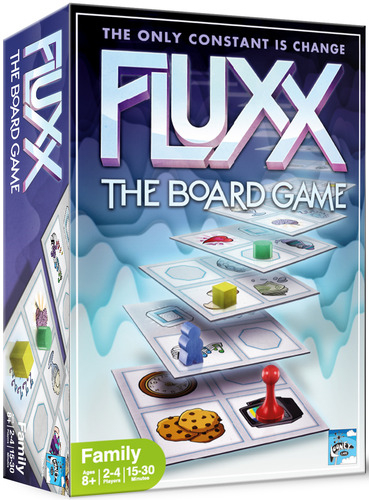
The Basics:
- For ages 8 and up
- For 2 to 4 players
- Approximately 30 minutes to complete
Geek Skills:
- Active Listening & Communication
- Counting & Math
- Logical & Critical Decision Making
- Reading
- Pattern/Color Matching
- Strategy & Tactics
Learning Curve:
- Child – Easy
- Adult – Easy
Theme & Narrative:
- None
Endorsements:
- Gamer Geek rejected!
- Parent Geek approved!
- Child Geek approved!
Overview
It’s in our nature to attempt to control the uncontrollable. It’s a hopeless venture. We define and categorize the unexplainable, create rules that can be broken, and lie to ourselves to create new truths. One could say this is a rather bleak way to look at things, but I find it fascinating. How else can one navigate the tempest to obtain control without first defining their place in the chaotic maelstrom? In this game, chaos is an agent of change and a path to victory.
Fluxx: The Board Game, designed by Andrew Looney and published by Looney Labs, is comprised of 9 tiles, 1 “Rules” pegboard, 1 “Win” pegboard, 100 cards, 12 Player pieces (3 per player in the colors yellow, blue, red, and green), and 8 pegs. The Player pieces and are made of solid wood, the pegs are made of plastic, the tiles and pegboards are made of thick cardboard, and the cards are made of thick cardstock. The game components are all high quality and durable, but there is one issue worth noting. The pegs do not stay in the pegboards, which seems like a HUGE flaw that should have been caught prior to mass production.
Game Set Up
To set up the game, first find and place the “Rules” and the “Win” pegboards to one side. Place a peg in each of the left-most holes found on the “Rules” pegboard and place a peg in the “3” hole found on the “Win” pegboard. Optionally, the peg could be placed in the “4” hole if a longer game is desired.
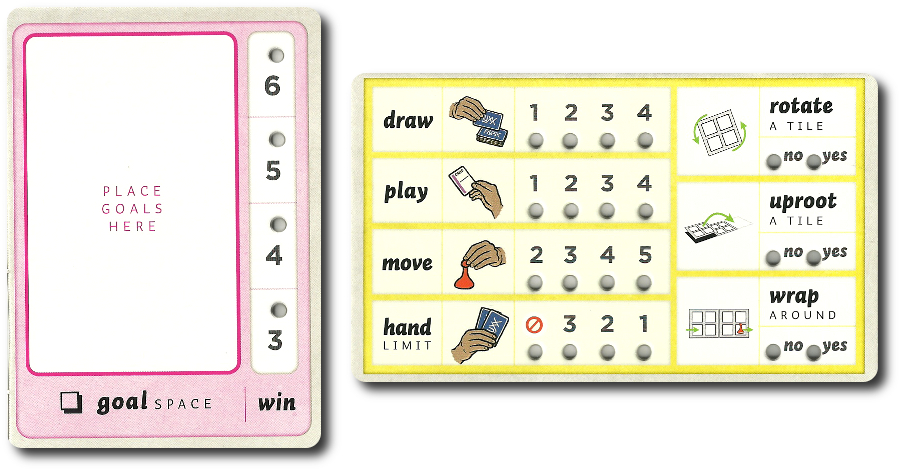
“Win” pegboard on the left and the “Rules” pegboard on the right
Second, find the “Start” tile and place it in the center of the playing area. Take the remaining 8 tiles, shuffle them, and then place randomly around the “Start” tile to form a 3×3 square with the “Start” tile located in the center.
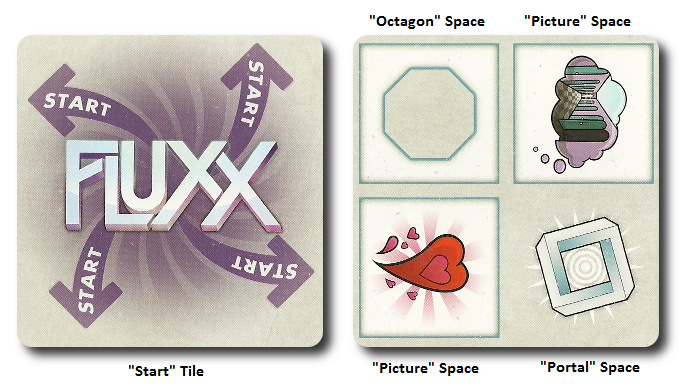
Third, have each player select a color (yellow, blue, red, or green) and take all three Player pieces of that color. Players then place all 3 of their Player pieces on the “Start” tile. Any unused Player pieces are removed for the duration of the game. Find the “Color” card that matches the player’s selected color and have them place it in front of them, face-up. Note that these cards will shift during the game, meaning a player’s selected color might be replaced with another!
Fourth, take and shuffle the cards. Once shuffled, search through the deck and remove the first 5 “Goal” cards found. All players can look at these “Goal” cards at this time. Once all the players have had an opportunity to review the “Goal” cards, they are shuffled and placed face-up on the “Win” pegboard.
Fifth, shuffle the remaining cards in the deck, deal out 3 cards to each player (face-down), and place the remaining cards face-down next to the game tiles. This is the draw deck for the duration of the game. Leave room next to the draw deck for a discard pile.
That’s it for game set up. Determine who should go first and begin!
Controlled Chaos
Fluxx: The Board Game is played in turns with no specific number of turns or rounds in a single game. On a player’s turn, the “Rules” pegboard will determine what actions are taken. The “Draw” and “Discard” actions must be taken in a specific order, but the other actions can be taken in any order the player likes. The actions available are summarized here.
Draw
This first action the player must take on their turn requires them to draw the specified number of cards from the draw deck as indicated by the peg position on the pegboard. The number of cards drawn will range from 1 to 4. Cards are drawn from the draw deck and added to the player’s hand.
Move
This action can be taken before or after the “Play” action. The peg position indicates the total number of moves the player can divide among their 3 Player pieces. The number of moves will range from 2 to 5. A single move is considered 1 “space”. A “space” is defined as one of the four squares on a single tile. A Player piece can only move up or down, left or right, and never diagonally. When exiting the “Start” tile, the Player pieces can only do so by way of one of the four exit arrows. These exit arrows point to a specific space on adjacent tiles.
There are three different kind of spaces:
- Picture: This space on the tile shows an image of some kind (Cookies, the Sun, Milk. etc). Only 1 Player piece can occupy a “Picture” space at a time.
- Octagon: This space on the tile can contain an unlimited number of Player pieces at anytime.
- Portals: This space on the tile instantly moves a Player piece to the matching portal space, be it from a player initiated move or a “bump”. Movement from one “Portal” space to the other does not count as a move (you move once onto the “Portal” space and are automatically shifted to the other “Portal” space position), unless the Player piece starts its movement on a “Portal” space. Like the “Octagon” space, the “Portal” space has no Player piece number limits.
If moving a Player piece onto a “Picture”space, any Player piece (including ones that belong to the currently active player) that previously occupied it are “bumped”. Bumped Player pieces are moved to any adjacent (not diagonal) space that allows the Player piece to occupy it. A bumped Player piece can never occupy the space the Player piece that initiated the bump just moved from. If a bumped Player piece cannot be moved, the move is illegal and cannot be completed. The player will have to discover some other route to get to where they want to go.
In addition to the normal move, there are several special moves listed on the “Rules” pegboard:
- Rotate: This special move allows the player to use one of their movement to rotate any tile in any new direction they like.
- Uproot: This special move allows the player to use one of their movement to take and place a tile to any new location. When placed, it must be adjacent to at least 1 other tile and its current orientation must be preserved. When determining if the new location of the tile is legal, simply trace a path from the “Start” tile. If a player could get to the uprooted tile using normal movement, the tile is legally placed.
- Wraparound: This special move allows the player to use one of their movement to move off the edge of one tile and relocated the Player piece to the edge of another tile located on the other side. The Player piece could move from one side of the game playing area to the other or jump over gaps in the tiles.
Play
This action can be taken before or after the “Move” action. The peg position indicates the total number of cards the player can play from their hand. The cards played can be in any order. In total, there are 4 different card types.
- Action: These cards define a specific action that is immediately taken. Whatever the “Action” card states, even if it playing other cards, is considered 1 play. Once the “Action” card and any other cards are resolved, the “Action” card is discarded.
- New Rule: These cards shift the peg locations on the pegboards. Once the pegs have been shifted accordingly, the “New Rule” card is discarded. The pegboard lists the minimum and maximum values a peg can represent. If the “New Rule” would move a peg beyond the boundary, it is ignored. However, if the “New Rule” states the player can increase or decrease the value, the player must move the peg in whatever direction to satisfy the new rule. Additionally, if a new rule changes the number of cards that can be drawn or the moves that can be taken, the active player always draws more cards and takes more moves, but never looses cards or undoes previous moves as the result of a new rule.
- Leaper: This card allows the player to move one of their Player pieces to a specific “space” on the tiles instantly. Any Player pieces that currently occupy the space are moved to the “Start” tile if the “space” is not an Octagon or a Portal. Although this moves the Player piece, it is not considered a move. Once the “Leaper” card is played, it is discarded.
- Goal: These are just like the “Goal” cards on the “Win” pegboard and are placed on top of any “Goal” card currently showing. Each “Goal” card indicates 2 “spaces” the player must occupy at the same time in order to achieve the goal. If the player does at any time, the “Goal” card is claimed. Claimed “Goal” cards are placed in front of the player to indicate how many goals they have achieved so far. If the “Win” pegboard does not have any “Goal” cards on it, the space remains empty until a new “Goal” card is played.
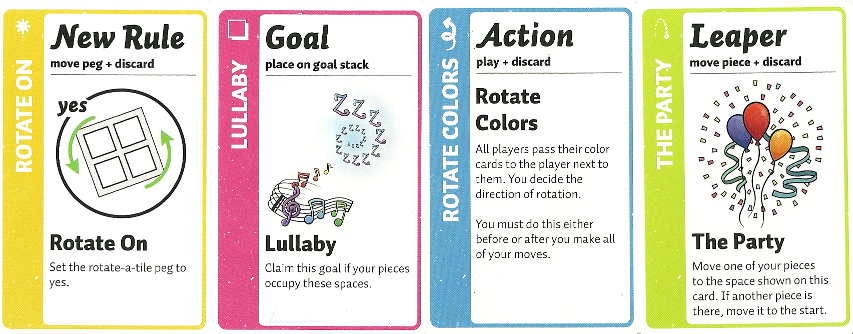
Discard
The last action the player takes is checking their hand size. The peg position indicates the total number of cards the player can have in their hand at the end of their turn. The number of cards a player can have ranges from zero (none) to 3. If the player has more cards than what is currently allowed, they must discard until their total hand size is equal to the current hand size limit.
Once the player has completed their turn, the next player in turn order sequence (going clockwise) takes their turn. This continues until a player has won the game.
Obtaining Order
The game continues until a player has successfully collected a number of “Goal” cards equal to the current peg position on the “Win” pegboard. If two or more players meet the goal achievement total at the same time, play continues until one player has completed more goals than their opponents.
To learn more about Fluxx: The Board Game, visit the game’s web page.
Prediction
I’m going to tell you right now that this is going to be a hard or very easy sale to my play groups. For those who love the Fluxx card games (we’ve reviewed Oz Fluxx and Cthulhu Fluxx, if you are interested), they are going to be very eager to try the newest Fluxx offering simply because it’s Fluxx. I might have to beat them off with a stick. For those who don’t, they’ll beat me with a stick for even suggesting we play the board game version of a card game that gives them a migraine. Such is the strangely polarizing affect that Fluxx games have on players. I really can’t explain it and think it’s somewhat ludicrous, but you’ll be hard pressed to find a player who doesn’t have a very strong opinion regarding the game.
So we know where we stand with our groups. If they like Fluxx, I predict they’ll like Fluxx: The Board Game, and if they hate it, they’ll continue to do so. But to what degree? Ah, that’s the real question here! The card game version of the game is fast to set up and can be fast to play…or very long. It all depends on how the game is played out. I’ve played a few Fluxx card games where they were over in less than 10 minutes and a few that lasted over 30 minutes. Fluxx: The Board Game appears to be a bit more streamlined and the specific requirements to win a “Goal” card are always available. I would assume that this will make the games a lot less chaotic, despite the fact that the tiles can move. This might appeal to those who have always found the card game version of Fluxx to be too random.
But will the game change anyone’s mind about how they feel about Fluxx in general? I doubt it.
Teaching the game is pretty straight forward. The pegboards do a good job of keeping all the rules straight, but only when the pegs stay in their holes. Any player who is familiar with Fluxx will understand how to play the game without issue. Anyone knew to Fluxx will need a bit more hand holding, but this is honestly not that difficult of a game. The real difficulty comes in managing actions and determining how best to maneuver to achieve goals. You can’t teach that, especially when the game itself is always changing.
After explaining the game to my two oldest little geeks, my 6-year-old excused himself from the table. When I asked him why, he said, “I’d rather play the card game,” and off he went to play LEGOs. My oldest little geek was ready to play it and was shuffling the cards when I returned to the table. Having no further questions regarding game play, I asked him his thoughts on the game so far.
“This would appear to be the board game version of the card game. I think I’ll enjoy it.” ~ Liam (age 9)
Yep, he nailed it in a very generic way. Let’s play Fluxx: The Board Game and see if it further reinforces our love or hate for the game.
Final Word
The Child Geeks enjoyed the board game and did very well. For those Child Geeks who had a hard time keeping track of the changes with the card version of the game, the “Rules” pegboard did an excellent job of helping them keep everything in order. The one problem here, however, is that the pegs kept falling out more and more the longer we played the game. This annoyed both Child and Parent Geeks to no end. But when the game was done and the Child Geeks had a moment to reflect on it, they found Fluxx: The Board Game to be an enjoyable experience. When I asked if they wanted to play a themed card game version of Fluxx or the board game again, they always wanted to play with the cards. The lack of theme and drabness of the game board components did little to hook the Child Geek’s imagination, but the game play was enough to keep them interested. Note that a Child Geek will need to be able to read to play the game. Hand management and knowing how the cards work is key to a player’s success. If a Child Geek has to have their cards read to them, that is going to reduce their level of fun. We suggest pairing up Child Geeks who cannot yet read with older geeks if they want to play.
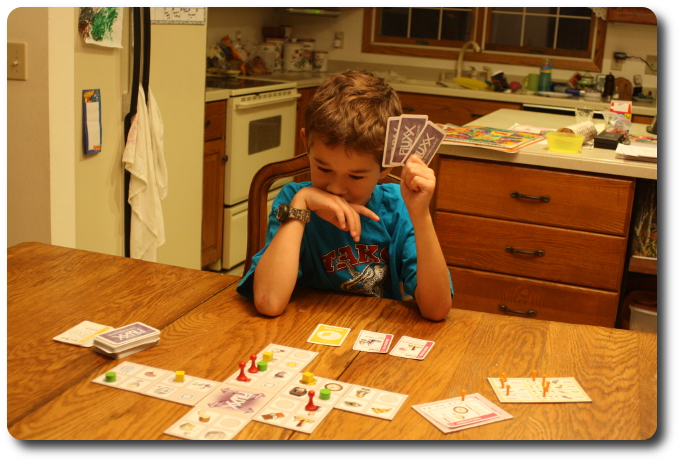
My little geek contemplates his moves after a big shift in the tiles
The Parent Geeks were very curious about how Looney Labs could make a board game version of a card game. They eagerly sat down at the table and gave it a play. When they pushed away from the table, they had some mixed feelings about the game. According to one Parent Geek, “I don’t know. It’s OK, I guess, but I prefer the card game.” Most of the Parent Geeks nodded in agreement, except a few. According to a Parent Geek who thought the board game version was pretty good, “This feels like a better and more streamlined version of the card game. I like that and I like how everything fits together. It feels less chaotic, but it’s still clearly Fluxx.” The Parent Geeks voted to approve Fluxx: The Board Game due to its ease of play, interesting tile shifting game mechanism, and its more streamlined game play.
The Gamer Geeks just about throttled me when I put the board game in front of them. Fluxx has a bad reputation with the gaming elitists and the board game version was unwelcomed right from the start. My primary concern here was getting the Gamer Geeks to play the game without prejudice. Impossible. This is Fluxx, after all. Surprisingly, however, some of the Gamer Geeks found the board game version to “not be that bad”. According to one of these Gamer Geeks, “I hate, hate, HATE the card game, but I would play this again if I was forced to.” And that’s about as good as it gets when it comes to praise. Overall, the board game did nothing to shift the Gamer Geeks’ opinions on the Fluxx franchise. A few of them enjoy the card game occasionally (Cthulhu Fluxx is a good example), but the board game was met with little to no approval. The Gamer Geeks did enjoy some of the game mechanisms, specifically the placement and shifting of the tiles, but that was quickly trumped by the constantly falling pegs. All the Gamer Geeks agreed that the board game version was a more streamlined and easier to follow version of the card game. They also all agreed to reject it.
OK, here’s the deal. This is essentially Fluxx chaos mechanics using a game board. That introduces new game play that might be of real interest to some new players who are just now getting into board games and for those who enjoy Fluxx (the card game version). And that’s it. I wouldn’t say the game is lifeless, but it doesn’t have much in the way of heart. All speculation on my part, mind you, but the game itself feels like a retooled version of the card game in hopes of appealing to a player base who doesn’t like card games. Nothing wrong with that, but anyone who is already familiar with Fluxx (again, the card game version) is going to find the lack of theme and the extra time it takes to set up and play the game to provide little in the way of fun or value. It’s like watching a movie you are very familiar with using a mirror. It’s slightly different, but never enough to make it a unique or remarkable experience.
So who in the heck is this game for? I honestly don’t know. Fluxx is a brand name that is exceedingly well-known in the gaming hobby world, continues to sell like crazy, has lots of different themes to appeal to just about everyone, and is very well designed. The board game version of the card game brings nothing to the table except more bits that do little to improve game play or excitement. But I can’t say this is a bad game. It certainly isn’t. It provided entertainment and made our players think. It’s just feels like an unnecessary game, especially when we consider the higher price point and the total lack of theme that so many Fluxx players enjoy. I can see this being a good gateway game, but I doubt it would be played as often as the card game version. I can also see Fluxx: The Board Game selling well at big box stores like Target and Wal-Mart.
I’m not big on the “thumbs up” or “thumbs down” approach to reviews as that leaves little in the way of continued discussion on the merits of what is being offered. Games tend to grow on you and there is most certainly a player for every game and a game for every player. Fluxx: The Board Game has merit, but just wasn’t my kind of game. If feels like Fluxx, but has a unique style of play that is all its own. It didn’t excite me, but it did entertain me. Ultimately, I think “interesting but forgettable” is how I would describe it. It did little to disappoint or please. A solid “meh” from me.
This game was given to Father Geek as a review copy. Father Geek was not paid, bribed, wined, dined, or threatened in vain hopes of influencing this review. Such is the statuesque and legendary integrity of Father Geek.




Appreciate the review. I’ve read/seen some where people matched those responses. “It’s still Fluxx, but I’d play this if I had to.” For me, I can pretty much take or leave Fluxx. When it goes on forever, it’s a beating. When it goes pretty quickly, it can be entertaining. It’s still not a great game, but it’s passable. This looks like something I’d have to give a try and I know my daughter would be up for it. My wife would probably hit me if I brought it near her, though. 🙂
Thanks for taking the time to read the review and leave a comment.
I personally didn’t think this game brought much to the table other than more Fluxx played slightly different. That, in and of itself, is passable if you like Fluxx to begin with, but the constantly falling pegs was a real downer. If you enjoy or can tolerate the card game version, I’d stick with that.